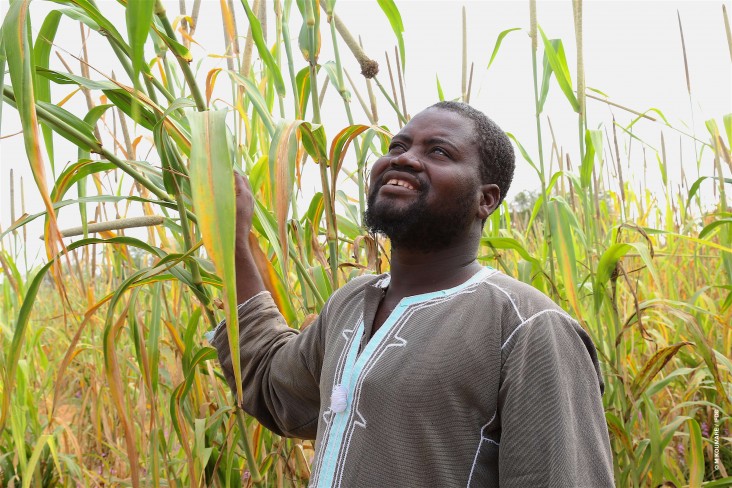Speeches Shim

July 2018 — The village of Bankass in the Mopti region of Mali was once known for its excellent millet and sorghum production. Nowadays, however, the impact of weather fluctuations is felt throughout the country, especially in areas like Bankass with low rainfall and weak soil.
Thirty-three-year-old Mamoudou Ouedrago is married to two women and is the father of five children. He teaches the Quran to village children and, during the agricultural season, works on his 6-hectare farm where he grows millet and sorghum.
In the past, after the harvest season, Ouedrago would move to the city to find a job since he could not support his family with farming only. He lived away from his family for six or seven months of the year.
In April 2014, USAID’s Feed the Future Scaling up Fertilizer Deep Placement and Micro Dosing Technologies in Mali project began operating in Mopti, Segou, Sikasso and Timbuktu regions.
“When the farmers were recommended for the first time to use kèmèkunu [micro dose in the Dogon language], they had concerns on its efficiency. As it was something quite new to me, I tried it, but in a small plot. When the harvest time arrived, I got more than expected. Today, I apply this technology in the whole field,” said Ouedrago.
Micro dosing consists of applying very small, affordable amounts of fertilizer directly to plant roots. This method increases fertilizer efficiency and can double the productivity of millet and sorghum crops. The increased production of vegetables in the area impacts the nutritional quality of producers’ households as well as other households in the community.
The new method also protects valuable ecosystems. Excessive use of fertilizers causes pollution of run-off and groundwater. Because micro dosing reduces the amount of fertilizer used, it helps to decrease nitrate levels in groundwater and surface water.
The micro dose technology was so successful in the targeted regions that the National Directorate of Agriculture recommended that all millet and sorghum farmers apply it. Since 2014, more than 112,000 farmers, of whom 12,500 are women, have cultivated nearly 118,000 hectares using the technology.
While the technology improved resource-poor farmers’ access to quality and nutritious food in Mali, it also helped the government to reduce fertilizer subsidies. Since 2014, subsidized fertilizer has decreased from nearly 11.8 million tons to 4.1 tons — a savings of 7.7 tons.
Ouedrago previously harvested only 0.7 tons of crops per hectare on his millet and sorghum farm. Now, with the micro dose technology, he can harvest up to 1.2 tons per hectare. He also saves significantly on investment in fertilizer and seed. He shares his experience with producers in surrounding villages.
“Since I began using micro dose technology, I have not bought any cereal till now,” said Ouedrago. “Every Friday, I visit the producers of neighboring villages to let them know about the benefits of the micro dose.”
The USAID fertilizer project runs from 2014 to 2019.
LINKS
Follow @USAIDMali, on Facebook

Comment
Make a general inquiry or suggest an improvement.